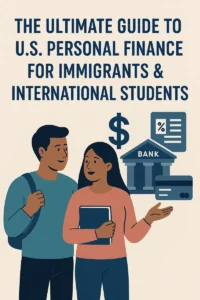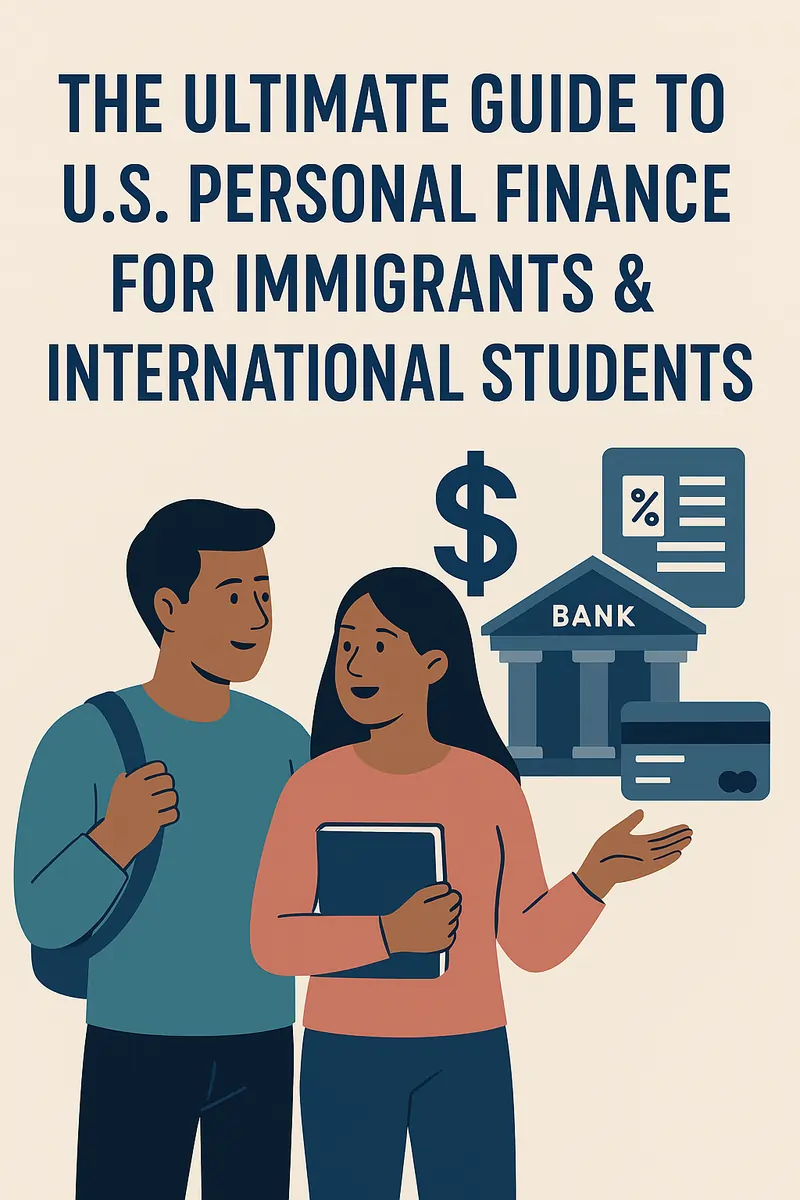🌎 The Ultimate Guide to U.S. Personal Finance for Immigrants & International Students
Starting a new life in the U.S. is a bold move filled with opportunity—but it can also be financially overwhelming. If you’re an immigrant or international student, navigating the complex U.S. financial system without prior experience can feel like learning a new language with unfamiliar rules.
That’s where The Ultimate Guide to U.S. Personal Finance for Immigrants & International Students steps in. This all-in-one resource is designed to help you manage your money smartly, build your financial future, and avoid costly mistakes from day one.
Whether you’re trying to open a bank account without an SSN, understand U.S. credit scores, or figure out how to file taxes as an F-1 visa holder, this guide is your key to unlocking financial confidence in the U.S.
🏦 Understanding the U.S. Banking System
Types of Bank Accounts You Should Know
Most U.S. banks offer two main types of accounts:
-
Checking Accounts: Ideal for daily expenses, like rent, food, and subscriptions.
-
Savings Accounts: Great for emergency funds or long-term goals.
Each account comes with its pros and cons, so choose based on your financial habits and goals.
Step-by-Step Guide to Opening a U.S. Bank Account Without an SSN
Yes, it’s possible—even if you don’t have a Social Security Number. Many banks now accept alternative documents, including:
-
Passport
-
I-20 form (for students)
-
ITIN (Individual Taxpayer Identification Number)
-
Proof of U.S. address (such as a lease or utility bill)
Banks like Bank of America, Chase, and Wells Fargo have immigrant-friendly policies. Credit unions and local banks can also be flexible options.
Avoiding Common Banking Fees
Overdraft fees. Monthly maintenance fees. ATM withdrawal charges.
These are some common traps newcomers fall into. Pro tip: look for student accounts or online banks with zero fees, such as Chime or Capital One 360.

💳 Building Credit History in the U.S.
Why Credit Scores Matter
In the U.S., credit is not just for loans—it’s a lifeline. Your credit score affects everything from renting an apartment to getting a job. Yet many immigrants and students are unaware of how to build one.
Understanding U.S. Credit Scores: A Guide for Newcomers
Credit scores range from 300–850. Factors that influence your score include:
-
Payment history (35%)
-
Credit utilization (30%)
-
Length of credit history (15%)
-
Credit mix (10%)
-
New credit (10%)
Steps to Establish Credit as an Immigrant or International Student
-
Open a secured credit card (you deposit a security amount, which becomes your credit limit).
-
Ask to be an authorized user on a trusted friend’s or family member’s credit card.
-
Pay all your bills on time—yes, even your Wi-Fi and phone bills.
Top 5 Credit Cards for International Students in the U.S.
-
Deserve EDU Mastercard – No SSN required, designed for students.
-
Capital One Quicksilver Student – Great cashback perks.
-
Discover it® Student Cash Back – Matched cashback for the first year.
-
Bank of America® Travel Rewards for Students – Ideal for global travelers.
-
Petal® 2 Visa Credit Card – Considers alternative data like your bank history.
💼 Navigating Taxes and Employment
How to File Taxes as an F-1 Visa Holder
Even if you don’t work, you’re likely required to file Form 8843. If you earned U.S. income, you’ll also need to file a 1040-NR.
Free resources like Sprintax or school-sponsored tax prep services can help you navigate this maze.
U.S. Taxes for Immigrants: What You Need to Know
-
Know your residency status (resident or non-resident alien).
-
Keep copies of all forms (W-2s, 1099s, I-20s).
-
File on time to avoid penalties and remain in legal status.
Work Authorization and Financial Implications
If you’re on a student visa (F-1), you may qualify for limited work options like:
-
On-campus employment (up to 20 hours/week)
-
CPT (Curricular Practical Training)
-
OPT (Optional Practical Training)
Working without proper authorization can lead to visa revocation—don’t take the risk.
💡 Budgeting and Financial Planning
Budgeting Tips for New Immigrants Living in New York
Living in NYC is thrilling but expensive. Here’s how newcomers survive (and thrive):
-
Share housing or look for student dorms
-
Cook at home and limit dining out
-
Use student discounts and MetroCards
-
Track your spending with apps like Mint or YNAB
Creating a Budget on a Limited Income
A great rule of thumb? The 50/30/20 rule:
-
50% for essentials (rent, food)
-
30% for wants (travel, entertainment)
-
20% for savings or debt repayment
Saving Money as an Immigrant or International Student
Set up automatic transfers to a savings account—even $25 a month makes a difference. Use high-yield savings accounts from banks like Ally Bank or Marcus by Goldman Sachs.
Accessing Financial Aid and Scholarships
Many international students believe aid is off-limits—not true. Check out:
-
School-specific scholarships
-
Private organizations like EducationUSA or the Fulbright Program
-
Institutional grants or merit awards
🎓 Why This Guide Is a Must-Have for Every Newcomer
The Ultimate Guide to U.S. Personal Finance for Immigrants & International Students isn’t just another PDF.
It’s a blueprint.
With real-life examples, legal insights, expert tips, and action steps, this guide arms you with the knowledge to take control of your money from day one in the U.S.
📊 Expert Insight
“Financial literacy is the key to long-term success. The earlier you understand the U.S. system, the fewer mistakes you’ll make. This guide fills a critical gap for those new to the country.”
— Ana María Torres, Financial Coach and Immigrant Advocate
🙋 Frequently Asked Questions
1. Can I open a U.S. bank account without a Social Security Number?
Yes. Many banks accept foreign passports, student visas (I-20), and ITINs as valid ID. Check out our Step-by-Step Guide to Opening a U.S. Bank Account Without an SSN in the full guide.
2. How can I start building credit in the U.S. without a credit history?
Apply for a secured credit card or student card, pay bills on time, and keep balances low. Learn more in our section on Understanding U.S. Credit Scores: A Guide for Newcomers.
3. What’s the best way to file taxes as an international student?
Use non-resident tax prep software like Sprintax, and always file Form 8843 if you’re on an F-1 visa. See the full breakdown in How to File Taxes as an F-1 Visa Holder.
4. How much should I budget for living in the U.S. as a student?
It varies by city. For example, in New York, expect to spend $1,200–$2,500 monthly. Our section on Budgeting Tips for New Immigrants Living in New York breaks it down.
5. Where can I find scholarships or financial aid as an immigrant or international student?
Look into institutional scholarships, Fulbright, and EducationUSA programs. Explore full listings in our guide’s Accessing Financial Aid and Scholarships chapter.
📘 Ready to Take Control of Your Financial Journey?
Don’t let confusion and culture shock hold you back. With The Ultimate Guide to U.S. Personal Finance for Immigrants & International Students, you’ll gain the tools and confidence to manage your money with purpose.
👉 Grab your copy today on inversionesyfinanzashispano.shop
Your future self will thank you.

